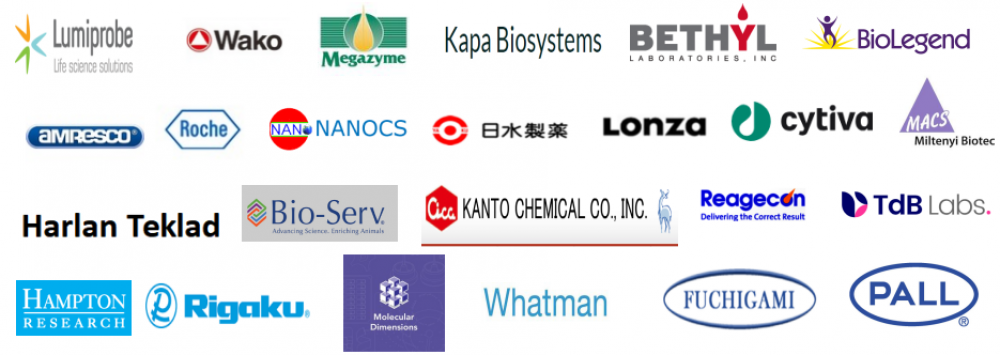Oxoid CM0983R Bolton肉汤基础培养基BOLTON BROTH BASE
BOLTON SELECTIVE ENRICHMENT BROTH
BOLTON BROTH
CODE: CM0983
A medium for the selective pre-enrichment of Campylobacter organisms in food samples.
一种用于选择性预富集食品样品中弯曲杆菌微生物的培养基。
| Typical Formula* |
gm/litre |
| Meat peptone |
10.0 |
| Lactalbumin hydrolysate |
5.0 |
| Yeast Extract |
5.0 |
| Sodium chloride |
5.0 |
| Alpha-ketoglutaric acid |
1.0 |
| Sodium pyruvate |
0.5 |
| Sodium metabisulphite |
0.5 |
| Sodium carbonate |
0.6 |
| Haemin |
0.01 |
| pH 7.4 ± 0.2 @ 25°C |
* Adjusted as required to meet performance standards
BOLTON BROTH SELECTIVE SUPPLEMENT
CODE: SR0183
| Vial contents (each vial is sufficient for 500ml of medium) |
per vial
|
per litre
|
| Cefoperazone |
10.0mg |
20.0mg |
| Vancomycin |
10.0mg |
20.0mg |
| Trimethoprim. |
10.0mg |
20.0mg |
| Cycloheximide |
25.0mg |
50.0mg |
Directions
Add 13.8g of Bolton Broth to 500ml of distilled water. Sterilise by autoclaving at 121°C for 15 minutes. Cool to 50°C. Aseptically add 25ml Laked Horse Blood SR0048 and 1 vial of Bolton Broth Selective Supplement SR0183, reconstituted as directed. Mix well and distribute into sterile screw top containers.
方向
将 13.8 克 Bolton Broth 添加到 500 毫升蒸馏水中。 通过在 121°C 高压灭菌 15 分钟进行灭菌。 冷却至 50°C。 无菌添加 25ml Laked Horse Blood SR0048 和 1 瓶 Bolton Broth Selective Supplement SR0183,按照指示重新配制。 充分混合并分配到无菌螺旋盖容器中。
Description
Bolton Selective Enrichment Broth is intended for the pre-enrichment of Campylobacter in food samples. Campylobacter are Gram-negative, spirally shaped microaerophilic organisms which may be present in raw milk, untreated water, improperly handled food and undercooked meats, poultry and shellfish. Human consumption of these organisms can result in a range of clinical illnesses from transient asymptomatic colonisation to severe dysentery. The symptoms of Campylobacter enteritis include diarrhoea, stomach pain, nausea, fever, headache and muscle pain. Complications of infection by Campylobacter jejuni may include unnecessary appendectomies as a result of abdominal pain, reactive arthritis or Guillian-Barré syndrome1. Campylobacter infection is recognised as one of the most common causes of bacterial gastroenteritis in humans, and the minimum infective dose may be as low as 500-800 cells1.
Since awareness of the apparent role of Campylobacter in human disease was heightened by Skirrow in 19772, a great number of culture media have evolved in response to the need to optimise performance. There was early recognition of the need for enrichment culture when examining food samples to overcome the damaging effects that food processing and preservation techniques can have on Campylobacter cells. Use of lower incubation temperatures in the early stages of enrichment is now widely established as an aid to cell recovery3. This principle was employed by Bolton in the development of his enrichment broth4.
Campylobacter can be injured by food processing and preservation procedures3. This makes them susceptible to selective agents which are tolerated by undamaged cells. False negative results are avoided through use of recovery medium such as Bolton Selective Enrichment Broth which increases the number of cells available for culture, first by resuscitating injured organisms and then encouraging them to multiply.
Bolton Selective Enrichment Broth contains nutrients to aid resuscitation of sublethally injured cells, and is formulated to avoid the need for a microaerobic atmosphere. Initial incubation is carried out at 30-37°C, depending on the type of food to be examined. After the pre-enrichment, the incubation temperature is raised to 42°C to increase the selective pressures on competing organisms.
Inclusion of sodium metabisulphite and sodium pyruvate in Bolton Broth quenches toxic compounds that may form in the culture medium. These additions also increase the aero-tolerance of the culture. The antibiotics contained in Bolton Broth Selective Supplement SR0183 optimise selectivity for Campylobacter spp. Vancomycin – active against Gram- positives. Cefoperazone – predominantly active against Gram- negatives. Trimethoprim – active against a wide variety of Gram-negative and Gram-positive organisms. Cycloheximide – active against yeasts.
Technique
One method of use is as follows:
Place 25g of food sample in 225ml Bolton Selective Enrichment Broth (prepared as described above) and homogenise the mixture using a Stomacher (or similar device). Bolton Selective Enrichment Broth does not require incubation in a microaerobic environment, but must be used in screw topped containers which are filled to within 20mm of the top4. Incubate for 4 hours at 37°C, followed by further incubation at 42°C . The broth can be subcultured after 24 hours and 48 hours on to either Modified CCDA (CM0739 + SR0155) or Preston Agar (CM0689 + SR0117 + SR0048)4.
For other methods please refer to BAM5.
技术
一种使用方法如下:
将 25g 食品样品放入 225ml Bolton 选择性富集肉汤(如上所述制备)中,并使用 Stomacher(或类似设备)将混合物均质化。 Bolton Selective Enrichment Broth 不需要在微需氧环境中孵育,但必须在填充到顶部 20 毫米以内的螺旋盖容器中使用。 在 37°C 下孵育 4 小时,然后在 42°C 下进一步孵育。 可以在 24 小时和 48 小时后将肉汤传代培养至改良的 CCDA (CM0739 + SR0155) 或普雷斯顿琼脂 (CM0689 + SR0117 + SR0048)4。
其他方法请参考 BAM5。
Storage conditions and Shelf Life
Store the dehydrated medium at 10-30°C and use before the expiry date on the label.
Store the prepared medium at 2-8°C for up to 2 weeks.
Appearance
Dehydrated medium: Straw coloured, free-flowing powder
Prepared medium: Broth: Straw coloured solution containing small black particles
储存条件和保质期
将脱水培养基储存在 10-30°C 并在标签上的有效期之前使用。
将准备好的培养基在 2-8°C 下储存长达 2 周。
外貌
脱水介质:稻草色、自由流动的粉末
制备培养基:肉汤:含有黑色小颗粒的稻草色溶液
Quality control
| Positive control: | Expected results: when subcultured on modified CCDA |
| Campylobacter jejuni ATCC® 29428* | Good growth; grey coloured colonies |
| Negative control: | |
| Escherichia coli ATCC® 25922* | No growth |
* This organism is available as a Culti-Loop®.
References 参考文献
1. National Advisory Committee on Microbiological Criteria for Foods (1994). Journal of Food Protection 57 (12): 1101-1121.
2. Skirrow, M.B. (1977). British Medical Journal 2: 9-11.
3. Post, D. E. (1995). Food-Borne Pathogens Monograph Number 3 Campylobacter .
4. Bolton, F.J. (1995) Personal communication.
5. Hunt, J.M. (1998) Campylobacter. In: F.D.A. Bacteriological Analytical Manual, 8th Edition (Revision A) 7.01-7.27. AOAC, Arlington Va.
图片仅供参考,请以实物为准。
若本网站没有及时更新,请大家谅解!
正文中列出的所有试剂只能用于测试或研究,不能作为”药品”,”食品”,”家庭用品”等使用。
我司所销售的化学试剂、原料等所有产品(包括但不限于抗生素类、蛋白质类、试剂盒类产品等)仅限用于科学研究用途,不得作用于人体。
库存信息随时变更,准确货期以下单时确认为准。
重要提醒:该中文说明为国内翻译版本,仅供参考,与官网英文版有不符之处,以英文版说明为主。
